New bark beetle pests in Michigan
Recent survey of Michigan bark and ambrosia beetles adds 23 new state records, including a few new pests to watch for.
Anthony Cognato, associate professor of Entomology at MSU and director of the A.J. Cook Arthropod Research Collection, directed a team effort to update the list of bark and ambrosia beetles recorded in Michigan using data from hand-collecting, trapping and museum records. Over 4,000 specimens were examined. The publication appears in the journal The Great Lakes Entomologist, vol. 42, pp. 101 – 120, 2009.
A total of 107 species of bark beetles were found in 45 genera, including 23 species which are new state records. Among the 107 species are 64 species of true bark beetles that breed in the inner bark, 27 species of ambrosia beetles that cultivate fungi in the sapwood, eight species that breed in the pith of twigs, and four species that breed in developing cones. Of interest to our tree care industry and nurseries are five new Michigan records of species that are known to be important tree pests. Below is a paragraph on each of these bark and ambrosia beetles.
Xylosandrus germanus, the black stem borer
This small ambrosia beetle leaves a 1 mm diameter entrance hole, from which a thin column of frass may protrude (Photos 1-3). The black stem borer is known to attack 200 spp. of plants in 52 families with most of the hosts being hardwoods. They prefer small stems less than 2.5 inches in diameter. Newly transplanted trees are vulnerable. This beetle has been found in nurseries on apparently healthy trees.

Photo 1. The black stem borer.
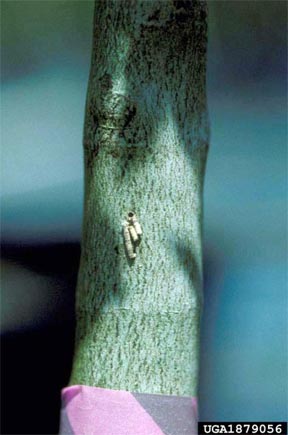
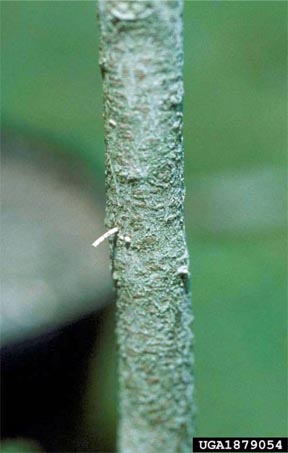
(Left) Photo 2. Entrance hole of the black stem borer. (Right) Photo 3. Frass column of black stem borer protruding from entrance tunnel.
Xylosandrus crassiusculus, granulate ambrosia beetle
This ambrosia beetle is known as a pest of nursery and orchard trees in the southern United States, and may pose a threat in northern states as well (Photo 4). It breeds in a wide variety of trees and shrubs including Bradford pear, golden raintree, Kwanzan cherry, chestnut, pecan, dogwood and willow. The beetles attack the trunk of the tree and push frass out of their galleries, forming a typical “toothpick” (Photo 5).
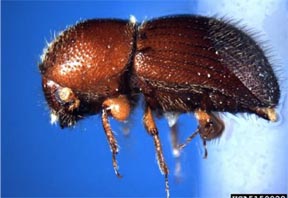
Photo 4. The granulate ambrosia beetle.
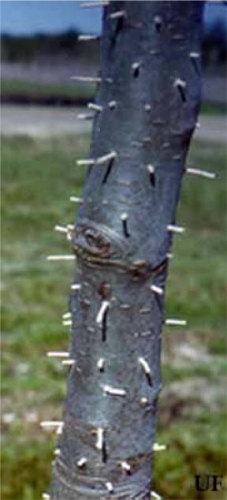
Photo 5. Toothpick-like frass columns made by the granulate ambrosia beetle.
Scolytus schevyrewi, banded elm bark beetle
In some western range states this insect is now the most abundant bark beetle on elms. It attacks drought-stressed and other weakened elms, and can vector Dutch elm disease (Photo 6).
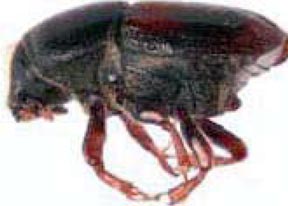
Photo 6. The banded elm bark beetle has a dark band across the brown elytra (wing covers).
Scolytus mali, larger shothole borer
The larger shothole borer attacks weakened Malus, Pyrus, Sorbus, Prunus and Ulmus trees (Photo 7).
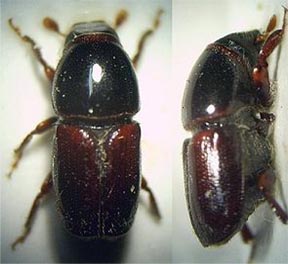
Photo 7. The larger shothole borer.
Ambrosiodmus rubricollis
There is not much information available on this exotic ambrosia beetle. It was reported to attack older, but healthy, peach trees in South Carolina (Photo 8).
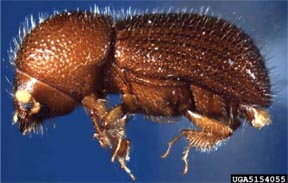
Photo 8. Ambrosiodmus rubricollis.



 Print
Print Email
Email

